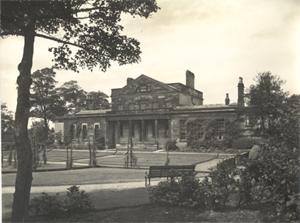In 1768, Lark Hill Mansion was built as the country home of the merchant and slave trader, Jonathan Blundell and contained a cockpit. Jonathan was the son of Bryan Blundell, the founder of the Bluecoat School and was more deeply involved in the slave trade than his father had been, even owning a number of enslaved people in Liverpool. He is known to have been involved in at least 56 slave
voyages between 1751 and 1780, and in Clubmoor he used these profits to
build his stone mansion. On the 13th of October 1773, one of his slaves, Thomas Gray, ran away as can be seen by an advert published on the front page of the Williamson's Liverpool Advertiser, 29th October 1773.
Jonathan used his slave trading wealth to invest in collieries and canal building and over the next few generations, the family would become one of the most prominent coal merchants in Britain, owning many mines in Lancashire.
In 1776 Richard Heywood I, a prominent slave trader and banker, bought the estate from Jonathan and lived there until his death in 1800 when, having no children, it passed to his brother, Arthur. He and his descendants would live in the house for almost 150 years. Arthur was the founder of the Liverpool private bank known as
Arthur Heywood, Sons and Company, later to become Martins Bank. Arthur died in 1836, and the Lark Hill estate passed to Elizabeth, the daughter of his elder brother, Benjamin. In effect the owner was Hugh Jones, her husband, who was already a partner in the bank. On Hugh's death in l842 the house passed to their son Richard Heywood
Jones, and in 1871 to his son, Benjamin Heywood Jones, who was still
living there in 1900. It was in the 1880s that the new imposing entrance gates and lodge at Tue
Brook were constructed. The coach drive, built on a curve up to the
house, was about 600 yards long. Before this time the only entrance to
the house was from Larkhill Lane, later to become part of Queens Drive-a
far less imposing entrance through an area which encompassed the estate
buildings and stables. From a 1906 map it is evident the estate was extensive and included a
wooded area with 'fish ponds' with a
pathway leading from the house to the ponds. In 1835 the location was
described as 'Club Moor Pits'. These were formerly either marl or clay
pits for agricultural use or possibly brick making.
Shortly after the first World War land was required for housing needs and the estate became fragmented with 2045 houses built on an area of 231 acres by Liverpool Corporation after they bought it from Arthur Heywood Jones. The house became a community centre and library, and the rest of the large estate with the ponds was laid out as a park.
The pathway through the gates that led to Larkhill Mansion was tree lined and still exists today as the central reservation of Muirhead Avenue. The Mansion that was used by the corporation as a Library for many years was demolished in 1962 after the building of the new Larkhill Library on Queens Drive.The park is largely covered with housing now and only a small area of the original grounds actually survives today.
.



No comments:
Post a Comment